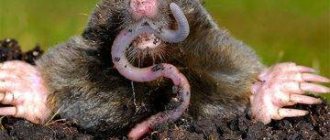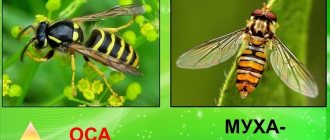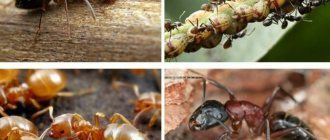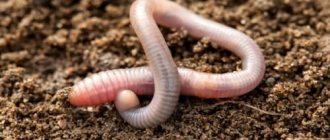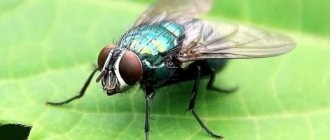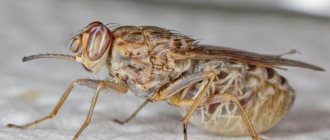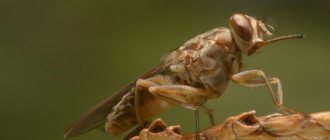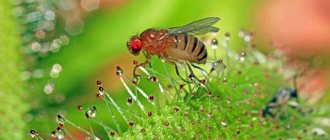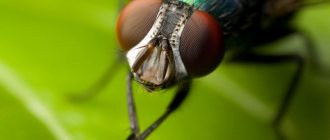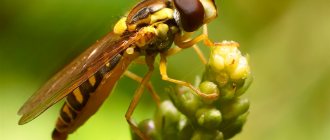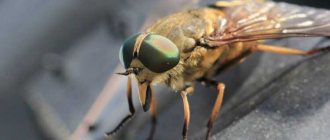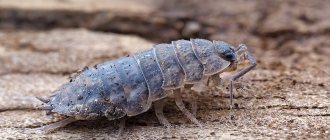Hover flies
One of the most useful insects in our area, which people try in every possible way to attract to their area. Externally, the striped insect is very similar to a wasp, but also has similarities with a fly.
- The abdomen is striped with a black and yellow tint, but unlike predators, yellow predominates, the stripes are narrow.
- The wings are different. They are more similar to a fly - wide, transparent. In flight they also behave differently from wasps.
There are more than 6 thousand species of hoverflies. Some strongly resemble wasps, others hornets, others bees. Distributed everywhere. In the warm season, they can be found in beds with carrots, dill, parsley, and flower beds with flowering plants. Adults feed exclusively on pollen and are one of the most important pollinators.
The parasites are the larvae. Outwardly they resemble leeches. They have no legs, are inactive, feed on aphids, insect eggs, and spider mites. During the season, huge colonies of parasites of garden, vegetable and flower crops are destroyed. An insect that looks like a wasp has nothing in common with it. But many predators try to avoid the fly.
Fighting methods
Summer residents and owners of personal plots are interested in how to get rid of pests in order to preserve their harvest. Gardeners and gardeners recommend using several methods - chemical and folk remedies. In many ways, control methods depend on the number of pests.
Chemicals
An insect similar to a fly - the hoverfly - dies from the use of such means:
- Aktara (110 rubles).
- Fly eater (10-25 rubles – 10 g packet).
- Inta-Vir (10-12 rubles).
- Tabazol (72-130 rub.).
- Agita (65 rub. – 20 g);
- Decis (36-56 rubles), etc.
Predator
A black insect that looks like a single ground wasp. The bug has an elongated body and mustache. Similarities with a wasp are found due to its striped abdomen. The upper part is covered in black, covered with wings, and wide black and yellow stripes are clearly visible below.
The predator bug itself is a predator; it easily attacks even poisonous spiders. Distributed everywhere. The brightest representatives live in tropical countries. It is active at night and remains hidden during the day.
Some species feed on the blood of humans and warm-blooded animals and are subject to destruction. Most of them attack insects and spiders. It has great endurance. It can sit in hiding for a long time, waiting for prey. As soon as he sees her, he immediately rushes to attack. Sticks the proboscis, launches a toxic substance. The poison instantly paralyzes the victim.
The same behavior is observed in road and ground wasps. These representatives of the wasp family are called predators due to the need to lay eggs in the body of the prey. The larvae dig into the belly and eat away from the inside. Until the end of the cycle, only the shell remains of the beetle, spider, and large larvae.
Reproduction
Among the Hymenoptera, the majority are those that reproduce by laying eggs, but the method and place are very different. Thus, some families choose a certain territory, hide eggs there, and then wait for the larvae to appear, feed them and continue to exist together. But things are not always so simple and rosy. Cuckoo bees deliberately hide their ovipositors among many others, thereby raising their offspring with individuals of a completely different species. There are also cases when newly emerged larvae of one species attack and devour the larvae of another, and maybe even their own brothers, without noticing it and arranging a full-fledged natural selection, at the end of which only a few survive.
The insect world is no softer than the animal world, and in many ways even surpasses it in cruelty, demonstrating various atrocities on the part of some species.
Glass butterflies
An insect that looks like a wasp with a long body may be a butterfly. The external similarities are striking. A distinctive feature is the wide transparent wings with a pronounced pattern in the form of oblong lines. The body is large, massive, similar to a large wasp. Colored in yellow and black wide stripes. Long, curled antennae are clearly visible on the head.
Glass butterflies
The flight is different. The butterfly flutters easily, does not make sudden movements, and does not create buzzing sounds, as is typical of wasps.
The most common types of glass butterflies in countries with temperate climates are currant, poplar, and apple. It is a typical representative of garden pests. The eggs hatch into caterpillars that feed on the insides of the shoots. They penetrate into the stems, under the bark. Glassworts are difficult to notice and remove, and cause great harm to gardening. The wasp is exclusively associated with similar colors.
Bee
Insects similar to wasps are bees. They are extremely often confused with each other. A bee and a wasp have some similarities in their lifestyle, they even sting just as painfully. The bee has a round shape, the head and chest are gray-black with thick, long yellow hairs. Massive paws, long whiskers are clearly visible. A striking distinctive feature is the absence of a “wasp waist” - a thin bridge between the chest and abdomen. The color is yellow-black, but the stripes are narrower and covered with yellow hairs.
Bees feed exclusively on nectar and form honeycombs from wax, which they produce themselves. Thanks to their ability to reproduce honey, they have long been domesticated and live in beehives. They are periodically attacked by the wasp family. This fact refutes the statement that wasps do not attack their own kind. The similarity in color must be explained by something else
Rider
An insect with a long body and a sting makes many puzzle over the name of this creature. The wasps are solitary wasps. They do not build typical nests and do not swarm. Distributed everywhere, including many genera and species. They differ in color and body length. Some have no wings at all, more like an ant.
The most striking representative is the equestrian with a long tail. An elongated black body, high limbs, narrow wings, and a sting. Unlike other wasps, ichneumon wasps use a sting to lay eggs. They pierce the victim’s body, inject poison, and lay their offspring. This is where the female's mission ends. The larvae develop independently. The victims include spiders, beetles, butterflies, and larvae of large insects.
Red Reaper Ant: 3.0
The red harvester ant provides a great service to farmers as it eats many pests. These ants have a nearly square head with a relatively long body without a spine, and their reddish-orange color distinguishes them from other ant species. The positive thing is that they attack rather reluctantly, although they do have a painful sting. Schmidt describes the sting from these ants as bold and relentless, and the bite feels like drilling out an ingrown toenail. According to the Pain Index, the pain of a red harvester ant bite is 3.0.
Longhorn beetle
Imitates the color of Plagionotonus wasps, a representative of longhorned beetles. Outwardly it resembles a bug. Hard chitinous cover, oblong body, head clearly visible, very long, curled mustache. There are no transparent wings, the insect rarely flies. Color black and yellow with stripes.
The body length of an adult reaches 22 mm. The female lays eggs in the wood. During its entire life it reproduces about 100 thousand of its own kind. The larvae gnaw through numerous tunnels and damage the tree. Transformation into an adult takes a long time - up to 10 years. A typical representative of pests with which humans wage a merciless fight.
An insect that closely resembles wasps is a representative of the same family - the hornet. The largest species, characterized by aggressive behavior. Destroys wasp and bee hives. The size of the body reaches 3 cm, the average wasp is 1.5 cm. Massive body, powerful jaws, strong limbs. The giant wasp bites painfully and the venom causes severe allergies.
Wasps are unique insects whose lifestyle, behavior, and physiological abilities are a constant object of study. Insects that have external similarities with them are no longer similar.
Bite
Each wasp has fairly powerful jaws called “mandibles.” They are used both for feeding on a variety of plant foods and for killing caught prey. For example, in the vast majority of cases, hornets, which attack even large insects like praying mantises and cockroaches, practically do not use a sting, but can simply use strong jaws, crushing the chitinous covers of their victim.
The wasp moves quite quickly, but at the same time it has far from the highest speed among insects, as a result of which even well-armed predators often end up being victims themselves. In particular, dragonflies and predatory duck flies feed on them.
Fly like a wasp
Hoverflies (lat. Syrphidae) are often found in vegetable gardens and summer cottages, where they actively pollinate flowers on garden and fruit crops.
They are called hoverflies due to the sounds they make when flying, similar to the murmur of running water.
They are widespread and are found on all continents at positive air temperatures. According to biological classification, scientists place them in the order of short-whiskers and the family of Diptera.
Syrphids use a remarkable ability for mimicry, having an appearance very similar to the stinging insects of bees and wasps, having the same yellow and black striped abdomen, as seen in the photo of the hoverfly, thanks to which they escape from the attacks of birds and predators. Hoverflies are virtuosos in the “flight” business: their ability to hover or loiter in one place, and then break off and quickly fly away, is their distinctive feature. It is due to the unique structure of the wings: one pair is normal, and the second has been reduced over time into club-shaped halteres, which helps the insect maintain balance and control stopping in flight.
Where do they live?
The habitat of representatives of this order is distributed throughout the world, so it is impossible even in general terms to identify the places where not only the entire order, but also some specific families live. They can settle in fields, pollinating or, conversely, destroying plants. In the forests, where they will simply live, not bothering anyone, or parasitize on trees. There are actually many options, and considering a specific species will be too difficult, and even pointless, since it will belong to a full-fledged family, the members of which can spread throughout the entire globe.
Types of hoverflies
Such striped flies have many varieties: in the world - up to 60 thousand, in Russia their number is 800. All types of hoverflies are distinguished by the different arrangement of yellowish and black stripes, as well as the diet of their larvae: some of them are herbivores, others are predators, still others eat tree bark.
The most common of them:
- The common hoverfly or flower fly with yellow stripes, reaches 12 mm in length, is a good pollinator, the larvae of which destroy garden pests;
- Onion hoverfly (Delia antique) – its size is about 1 cm, the larvae feed on the juice and pulp of bulbous plants;
- Wasp fly (Temnostoma vespiform) - a fly similar to a wasp in coloring and body shape, size up to 18 mm, its larvae consume rotten wood;
- The tenacious bee fly (Eristalis tenax) is a fly similar to a bee, 15 mm long, darker in color;
- Aquatic hoverfly or eristalis fly (Eristalis) - lives near standing ponds, swamps or puddles with musty water, has a special proboscis for breathing in order to consume air from the surface;
- Tufted hoverfly wasp (fasciolatum).
What do they eat?
Most Hymenoptera are pollinating insects, which means that they obtain all their nutrients from the pollen of plants with which they come into mutually beneficial contact. But there are many families that, on the contrary, destroy plants in order to get as much food as possible from them. It may also happen that a whole swarm of insects flies towards the animal, kills it and quickly eats it. There are not many such species, but they still exist and cause harm.
Among this species, not only pollinating insects are common, but also parasitic insects that attach themselves to some plant, tree or mammal, and then feed with it throughout their entire life cycle. Basically, this happens without much harm to the victim, but even so, the constant sucking of blood along with nutrients leads to the appearance of diseases in the animal, and for some reason it dies before the end of its allotted time. An insect that has parasitized a mammal dies along with its food source, but at the same time, some such species simply move to another, continuing to live and harm again.
Nutrition and life cycle
Along with bees and bumblebees, syrphid flies are pollinators and feed on nectar and pollen collected from plants and flowers. The sugar consumed from such food gives them the necessary energy, and pollen is needed in the form of protein for egg maturation and reproduction. They give preference to umbelliferous and asteraceous plants; they fly in meadows, visiting dandelions and other flowers, also among fruit bushes and trees.
The first appearance of adult flies occurs at the end of spring; mating usually occurs only in July, but the active summer will continue until the first half of August.
Adult female flies, similar to bees, when laying eggs, look for places where there will be rich food for future offspring, for example, a cluster of aphids or small spider mites. Hoverfly larvae appear after 3-4 days, their length is usually about 1 cm, and they look like maggots. They hardly move, but actively eat aphids; their daily diet is up to 200 individuals, due to which they gradually grow.
During its development, each larva is capable of absorbing up to 2 thousand small insect pests, making it a predator that benefits garden plants. However, some types of flies also have plant tastes. The onion hoverfly, for example, eats onion greens, which is why it is classified as a pest.
Gradually, the grown larva forms into a puparium - a shell similar to a drop of resin, inside which the insect matures. The adult flies out of the cocoon, after 12-14 days, after 1-2 hours it spreads its wings and is able to fly.
One female hoverfly lays about 200 white eggs per season, attaching them to grass or plant stems, or less often directly into the soil. Then generations change.
Top 10: the most creepy and dangerous insects in the world
Many insects are seemingly quite cute and harmless creatures. For example, butterflies or ladybugs. We often try not to notice others until they begin to get in the way or buzz in our ears. But some insects can frighten anyone and even cause fatal harm. These creatures are capable of causing terrible pain to their victims, because their bite is quite poisonous for this. Suffering can last for hours or even weeks. And the bites of certain species are fatal even to humans. Here is a list of 10 insects that you should never encounter!
10. Caterpillar of the genus Lonomia (Lonomia obliqua)
Photo: Centro de Informacoes Toxicologicas de Santa Catarina
This creepy caterpillar lives in South America, and at least several people die there every year from its poison. As can be seen in the photograph, the body of the lonomia is covered with small sharp bristles that secrete a powerful toxin, the penetration of which under the skin of the victim can cause extremely unpleasant consequences. The tiny creature was even nicknamed the “killer caterpillar,” but it is essentially just a larva of the Lonomia oblique moth.
The venom of this caterpillar can cause symptoms similar to gangrene throughout the body, causing bleeding in the brain and can even lead to death. The strong anticoagulant (prevents blood clotting) properties of the toxin cause large-scale internal bleeding, which ultimately leads to the most disastrous consequences. There are almost 500 confirmed cases of death from being stung by the thorns of this caterpillar.
9. Tropical ants of the species Paraponera clavata
The most painful insect bite in the world belongs to this inconspicuous creature. Paraponera clavata or sometimes the bullet ant is also the largest ant in the world with the most poisonous sting. The worker ant of this species grows approximately 2.5 centimeters in length and resembles a wingless wasp. The queen anthill usually reaches the same size. These insects have thick reddish-brown bristles and are much "furrier" than their other relatives. The dangerous species is found in Central and South America.
The bullet ant got its eloquent nickname because its bite can be compared to a real bullet wound. The poisonous sting causes serious suffering to the victim, and this unbearable pain will last almost a day. According to the Schmidt Sting Pain Index, the bite of a bullet ant corresponds to the fourth (highest) level of pain. This insect is much more insidious not only than the wasps and bees we are used to, but also than the red American harvester ant of the genus Pogonomyrmex, paper wasps of the subfamily Polistinae, and even pompylids (wasps that prey on tarantulas).
8. Giant scolopendra
Photo: Katka Nemcokova
These creatures grow up to 35 centimeters in length! Giant centipedes are probably the largest centipedes in the world. The insect is widespread in South America and the Caribbean. The body of this creature consists of 21-23 clearly visible segments of red or brown color, each of which is equipped with its own pair of bright yellow legs.
The giant scolopendra is very aggressive and irritable, and during a fight it clings to the enemy with all its legs. In addition, the creepy insect is also quite poisonous. The scolopendra toxin is so strong that it can kill most small animals it encounters in life. For humans, this poison is most often not fatal. However, this does not mean that its toxin will not cause you any harm at all. Symptoms of giant scolopendra venom usually include severe pain, swelling, chills, fever and general lethargy. In addition, the effect of the poison can be fatal even for a person if he exhibits individual allergic reactions to this substance.
7. Tsetse fly
Photo: britannica.com
Like mosquitoes, these flies love to drink the blood of mammals. True, the Tsetse fly does this much more unpleasantly for its victim than almost any mosquito. The insect's proboscis has tiny teeth that literally bite into the animal's skin with a death grip. These insidious insects carry dangerous diseases, and some of these infections can lead to a disease known as sleeping sickness (or African trypanosomiasis). If a person who is bitten does not receive timely treatment, they will most likely die.
The first symptoms of sleeping sickness usually include fever, itching, headache and muscle pain. As the illness progresses, the infected person begins to experience extreme fatigue and confusion. This is followed by numbness, poor coordination and sleep disturbances.
There are approximately 20 or 30 species of Tsetse fly in the world, and most of them live in Africa. The blood-sucking insect usually grows to 6-16 millimeters in length, and can be distinguished by its elongated proboscis, yellow and brown chitin, and the way its wings are folded - one on top of the other.
Tsetse flies prefer wooded areas and are most active in the morning. Most attacks on humans are carried out by males. Females usually prefer to cling to larger animals.
6. Human skin gadfly of the species Dermatobia hominis
Photo: entnemdept.ufl.edu
This species of gadfly is very similar to a bee, but it has more fine hairs and fewer coarse bristles. Typically, the botfly Dermatobia hominis only attacks livestock, deer and people. Females plant their larvae on ordinary mosquitoes, other flies and insects, which in turn pass them on to the future host. The eggs respond to the host's body heat and the hatching larvae burrow into the victim's skin. By the way, these flies are to blame for the extinction of cattle in the tropical regions of Central America.
The botfly larva Dermatobia hominis causes nasty skin abscesses. Sometimes, while showering or simply touching it, an infected person can even feel the larvae moving under their skin. Horrible!
You can get rid of the parasite with a simple surgical procedure under local anesthesia. Sometimes the larva can literally be squeezed out from under the skin if you press on it in the right direction. But this should be done only in individual cases. After removing the uninvited guest, the patient is prescribed antibiotics, and the wound on the skin, with proper attention, heals for about a couple of weeks.
5. Killer bee or Africanized bee
Photo: pestworld.org
The killer bee resembles an ordinary honey bee so much that only specialist laboratories can recognize the difference. The venom of an Africanized bee is no stronger than that of a normal bee. However, killer bees are distinguished by the fact that representatives of this species are much more aggressive than their relatives and attack the enemy in a large swarm, which makes them much more dangerous for humans.
Africanized bees live in small colonies and build completely unique hives, even in empty boxes, old cars, tires and wooden boxes. There are known cases where these evil creatures pursue people for several hundred meters (0.4 kilometers). This is definitely someone who shouldn’t be angry...
If you are attacked by a swarm of killer bees, the best thing you can do is run in a zigzag pattern and quickly find shelter from the overexcited insects. Never jump into the water to hide from these bees, because they won’t leave you alone anyway. The insidious creatures will wait until you return to land, so you will only get your things wet, become hypothermic, and prolong the chase even more.
4. Dorylins (Dorylus)
Photo: britannica.com
Dorilin ants gather in colonies, the number of which sometimes reaches up to 22 million individuals! However, these insects do not tend to build long-term anthills; instead, they constantly migrate and find a new nest every day. These creatures kill any other insects that come their way. That is why they are always on the move and on the road practically do not experience any problems with provisions. The dangerous species is found mainly in African forests.
Dorilins attack anyone who gets in their way, including snakes, birds, mammals, and even humans. The main weapon of these ants is their powerful and sharp jaws, and they are also quite smart hunters, because dorilins often climb higher into trees and bushes to get a better look at their prey.
The predatory insect is a fairly large representative of its family and sometimes grows up to 2.5 centimeters in length. These ants do not bite their victims very often. Instead of biting, they prefer to tear prey apart with their powerful mandibles (oral devices that function as jaws). Alone, Dorylin poses almost no threat, but when Dorylus ants unite into multimillion-dollar colonies, they become an indestructible army.
3. Giant Asian murder hornet or Vespa mandarinia
The Asian giant murder hornet is the largest hornet in the world. These insects are native to East Asia and are most often found in the mountains of Japan. Murder hornets are known for their extremely aggressive nature and fearlessness.
Vespa mandarinia feeds its young with honey bee larvae and, in the process of preying on them, destroys entire hives of unfortunate victims. These hornets have very strong and mobile mandibles, which allows them to kill ordinary bees right in their nests. One giant Asian hornet can tear apart about 40 bees in just 60 seconds.
The murder hornet's sting grows up to 6 millimeters in length, and this is enough to infect a person with quite dangerous poison. In 2013, more than 40 people died from the sting of these hornets, and more than 1,600 local residents sought medical help. Repeated attacks by murder hornets have even forced authorities to mobilize a special medical team with trained personnel who know exactly how to help stung people. Teams of firefighters have already taken care of the giant Asian hornets themselves.
2. Caterpillar of the species Megalopyge opercularis
Photo: National Geographic
This fluffy caterpillar looks very unusual and from a distance looks more like a lock of hair. The creature seems cute and just begs to be touched on its fluffy back, but that’s exactly what you shouldn’t do. It turns out that Megalopyge opercularis is the most poisonous caterpillar in all of America, and its toxin can cause incredible pain.
A bite from this cute little thing can cause throbbing pain, burning, rash, swelling, vomiting, abdominal pain, headache and even shock. To get rid of unpleasant symptoms, you must urgently clean the skin of caterpillar hairs (adhesive tape can help), wash the affected area with soap and apply a cold compress.
The caterpillar's fur looks very soft, but in fact it is poisonous needles that can pierce human skin. Megalopyge opercularis caterpillars are blob-shaped and are most often yellow, gray or reddish-brown.
The dangerous creature is found primarily in Florida, but it has also been spotted in the New Jersey and Texas areas. If you happen to visit the USA, don't let these cute fluffies fool you and don't try to pet them under any circumstances.
1. Ants of the species Pogonomyrmex maricopa
Photo: chandlerpestcontrol.net
Meet the most poisonous insect in the world! The Pogonomyrmex Maricopa harvester ant toxin contains various amino acids, peptides, proteins, polysaccharides, alkaloids and other substances that together form a deadly cocktail. When an ant attacks its prey, it digs into it with its mandibles and stings it until it faints.
The toxin of the Pogonomyrmex Maricopa ant is 12 times stronger than the venom of the honey bee. To kill an ordinary rat, this insect only needs to sting it 12 times. The lethal dose for humans is approximately 350 such injections. This number may sound like a very unrealistic scenario, but if you are attacked by a whole swarm of ants, the consequences can be truly dire.
When Pogonomyrmex Maricopa strikes its prey, it produces a pheromone that attracts other members of the colony. In response to a chemical signal, they rush to the aid of their brothers to join the attack and finish off the victim. The pain from one such sting, according to the Schmidt scale mentioned above, is equated to the third (one step less than the maximum) level of severity. If you are stung by such an ant, the unbearable pain will last on average from 4 to 6 hours. For most of their lives, representatives of the Pogonomyrmex Maricopa species live in the dry desert areas of the US state of Arizona.
Natural enemies
There are many reasons why Hymenoptera have to defend themselves and die. They have enemies among animals, for example, rodents or birds, but all this pales against the background of meanness on the part of other members of the squad. Wasps, for example, steal honey from bees, and the latter may even die because of this. Most of the higher brothers act and feed on the principle of destroying their neighbors, thereby small species die under the yoke of giants.
People also destroy insects, but this does not have much effect, since the large number of species compensates for small losses.
Midges
This collective name hides a mass of tiny (up to 2-3 mm long) stinging dipterous insects that externally resemble miniature flies. Like mosquitoes, it is the females who “hunt” people - they need blood and lymph as a source of protein for laying eggs.
Most often, midges are found near flowing bodies of water or in places where garbage accumulates. Their activity zone is daytime, low windy weather at temperatures of 8-30°C.
Oddly enough, the consequences of a bite from this little thing are much more serious than a mosquito bite - the swelling is greater, lasts much longer and hurts more. This is due to the fact that when attacked, the midge literally chews the tissue and injects poisonous saliva, causing bleeding and swelling.
Alas, midges are also often carriers of dangerous diseases, helminth eggs, and viral infections. Enzymes from midge saliva, injected into the wound during a bite, can cause a severe allergic reaction - simulidotoxicosis, accompanied by a sharp rise in temperature, chills, headaches, and inflammation of the lymph nodes.
You can protect yourself from the abundance of midges by using tight-fitting clothing and a hat with a mosquito net (mosquito net) impregnated with repellent. In case of a bite, treat it with ammonia, any alcohol infusion, iodine or brilliant green to reduce itching. The remaining measures for a midge bite are similar to those described above for a mosquito bite.
If an allergic reaction develops, you need to take an antihistamine tablet and consult a doctor immediately.
